

3D printers' could change our economy and our lives. (Phys.org) —"When you produce something yourself instead of purchasing it, that changes your relationship to it," says Chelsea Schelly, assistant professor of social sciences.
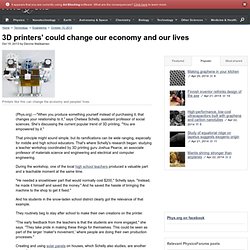
She's discussing the current popular trend of 3D printing. "You are empowered by it. " That principle might sound simple, but its ramifications can be wide ranging, especially for middle and high school educators. That's where Schelly's research began: studying a teacher workshop coordinated by 3D printing guru Joshua Pearce, an associate professor of materials science and engineering and electrical and computer engineering. During the workshop, one of the local high school teachers produced a valuable part and a teachable moment at the same time. "He needed a snowblower part that would normally cost $200," Schelly says.
And his students in the snow-laden school district clearly got the relevance of that example. They routinely beg to stay after school to make their own creations on the printer. Pearce agrees. Everything You Know About The Deficit Is Wrong: Fixing It Is Painless. People who insist that the US has a gigantic "spending problem" are ignorant of what really drives the deficit and the national debt, as Henry Blodget easily demonstrated in a series of charts.
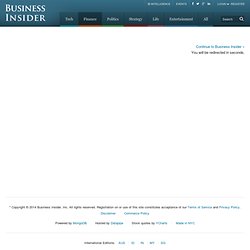
Closing the deficit is not just about lowering spending, relative to GDP, but also about increasing revenue from our very low levels. So how is that accomplished? When people talk about the deficit, they almost always use the "pain" metaphor. In almost any op-ed extolling the wisdom of the Simpson-Bowles plan, it's pointed out that we're going to need to take some pain. Obama has said that the Federal Government needs to tighten its belt, which is something that is painful. It's understandable why the pain metaphor is so popular. So this is just a popular idea: Take the pain now, be redeemed. Chomsky: The Corporate Assault on Public Education.
March 8, 2013 | Like this article?
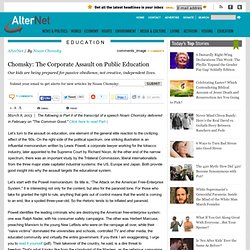
Join our email list: Stay up to date with the latest headlines via email. The following is Part II of the transcript of a speech Noam Chomsky delivered in February on "The Common Good. " Click here to read Part I. Let’s turn to the assault on education, one element of the general elite reaction to the civilizing effect of the ‘60s. Let's start with the Powell memorandum. Powell identifies the leading criminals who are destroying the American free-enterprise system: one was Ralph Nader, with his consumer safety campaigns.
Powell drew the obvious conclusion: “The campuses from which much of this criticism emanates are supported by tax funds generated largely from American business, contributions from capital funds controlled or generated by American business. Chomsky: Corporations and the Richest Americans Viscerally Oppose Common Good. March 7, 2013 | Like this article?
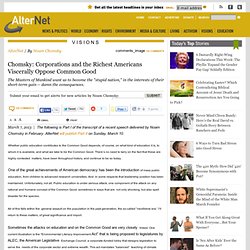
Join our email list: Stay up to date with the latest headlines via email. The following is Part I of the transcript of a recent speech delivered by Noam Chomsky in February. AlterNet will publish Part II on Sunday, March 10. Whether public education contributes to the Common Good depends, of course, on what kind of education it is, to whom it is available, and what we take to be the Common Good. One of the great achievements of American democracy has been the introduction of mass public education, from children to advanced research universities. All of this falls within the general assault on the population in the past generation, the so-called “neoliberal era.” Sometimes the attacks on education and on the Common Good are very closely linked. “Balanced teaching” is a code phrase that refers to teaching climate change denial, to “balance” authentic climate science – what you read in science journals. True, it is not unanimous. How to Fix America's Wealth Inequality: Teach Americans to Be Cheap - Noah Smith.
Today, wealth equality is closely tied to income equality.
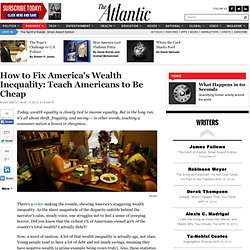
But in the long run, it's all about thrift, frugality, and saving -- in other words, teaching a consumer nation a lesson in cheapness. Reuters There's a video making the rounds, showing America's staggering wealth inequality. As the sheer magnitude of the disparity unfolds behind the narrator's calm, steady voice, one struggles not to feel a sense of creeping horror. Did you know that the richest 1% of Americans owned 40% of the country's total wealth? Now, a word of caution: A lot of that wealth inequality is actually age, not class. So what should we do about this? Or maybe not. The math of wealth is actually pretty simple: It all boils down to four things: 1. So one obvious thing we could do to make wealth more equal is - surprise! In other words, giving the poor and middle-class more income will boost the amount they are able to save, the percentage they are willing to save, and the return they get on those savings.